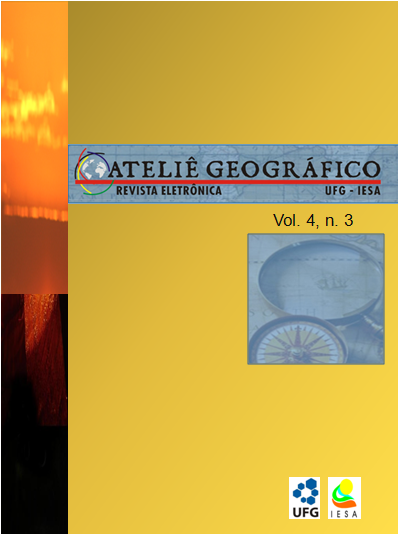SOCIAL-SPATIAL TRANSFORMATIONS OF THE TERRITORY OF GOIAS IN THE PERIODS OF 1930 AND 1970
DOI:
https://doi.org/10.5216/ag.v4i3.16645Abstract
The transformation of spaces from the extension reproduction of capital involved in the territory of Goiás, beyond the means of production and labor exploitation, economic, political and cultural conditions. Therefore, some periods were emblematic in the sense of these transformations, as represented efforts of the State, social actors and hegemonic, especially the processes and actions subjugated to logics of international capital. Thus, this study proposes to examine the process of modernization of Goiás territory from two periods: from 1930 to 1970, that had as spatial expression the regionalization of Goiano’s Mato Grosso, urged by the creation of Goiânia and the Agricultural National Colony of Goiás – CANG, and the period from 1960 and 1970, where we can mention the creation of Brasilia and programs like POLOCENTRO. This last period had as one of its spatial expressions the urbanization of Goias, found mainly in central and southern portions of this territory. In addition to understanding this process from a historical perspective, it is necessary understanding its geographical expression, in this case, evidenced by how the processes and actions get specialized and/or regionalized.
Downloads
Downloads
Published
How to Cite
Issue
Section
License
Autores que publicam nesta revista concordam com os seguintes termos:- Autores mantém os direitos autorais e concedem à revista o direito de primeira publicação, com o trabalho simultaneamente licenciado sob a Licença Creative Commons Attribution que permite o compartilhamento do trabalho com reconhecimento da autoria e publicação inicial nesta revista.
- Os autores não serão remunerados pela publicação de trabalhos na Revista Ateliê Geográfico. Além disso, os conteúdos publicados são de inteira e exclusiva responsabilidade de seus autores, ainda que reservado aos editores o direito de proceder a ajustes textuais e de adequação às normas da publicação.
- Autores têm permissão e são estimulados a divulgar seu trabalho online (ex.: em repositórios institucionais ou na sua página pessoal), já que isso pode gerar alterações produtivas, bem como aumentar o impacto e a citação do trabalho publicado (Veja O Efeito do Acesso Livre).


